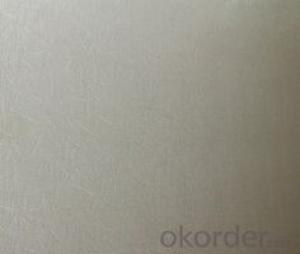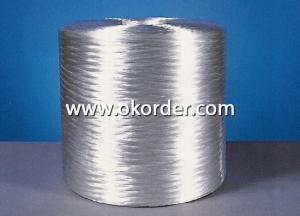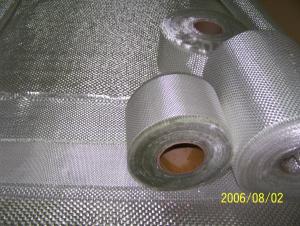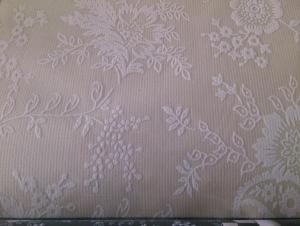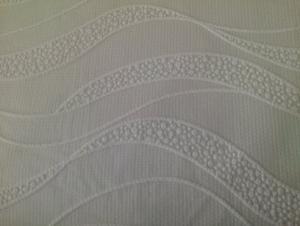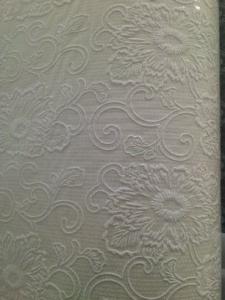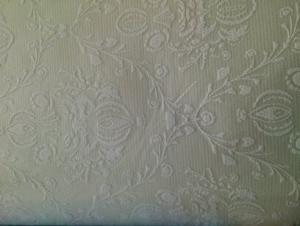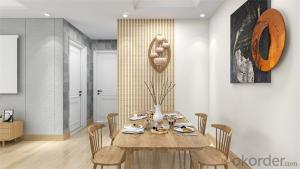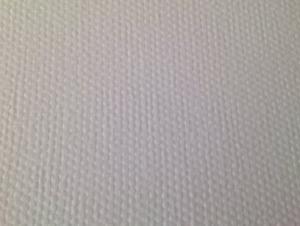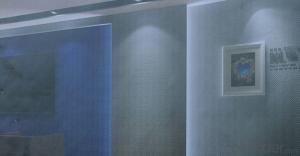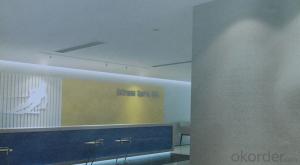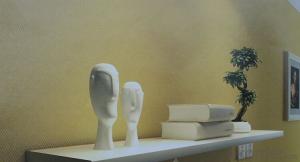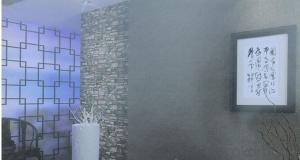Fiberglass Wallcovering Cloth for Home Decoration
- Loading Port:
- Shanghai
- Payment Terms:
- TT OR LC
- Min Order Qty:
- 100 m²
- Supply Capability:
- 100000 m²/month
OKorder Service Pledge
OKorder Financial Service
You Might Also Like
Fiberglass Wallcovering Cloth for Home Decoration
Specification of Wallcovering Cloth
.Environment-friendly
.Flame retardent
.Air permeability
.Waterproof
.Anti-corrosion
.Imcomparable strength
.Abundant patterns and colors
.Long life time
Packing Details
.Width:1m
.Length:25/50m
.Each roll of wallcovering cloth is wrapped in a shrinking polythene film,then put in carton
Introduction of wallcovering Cloth
Fiberglass wallcovering cloth,that combines the versatility of paint,from latex to epoxy,with the
strength and benefits of woven fiberglass textile yarns to meet the most demanding wall finish
requirments.Fiberglass textile yarns,as a kind of natural materials,are woven into various textures
and patterns and then treated with a natural starch binder for dimensional stability during the hanging
process.
Compared with traditional wall papers,fiberglass wall covering cloth has the following advantages:
Environment friendly,Flame Retardant,Air Permeability,Shock Resistance,Waterproofing,Anti-corrosion,Abundant Colors&Patterns.
Product Show
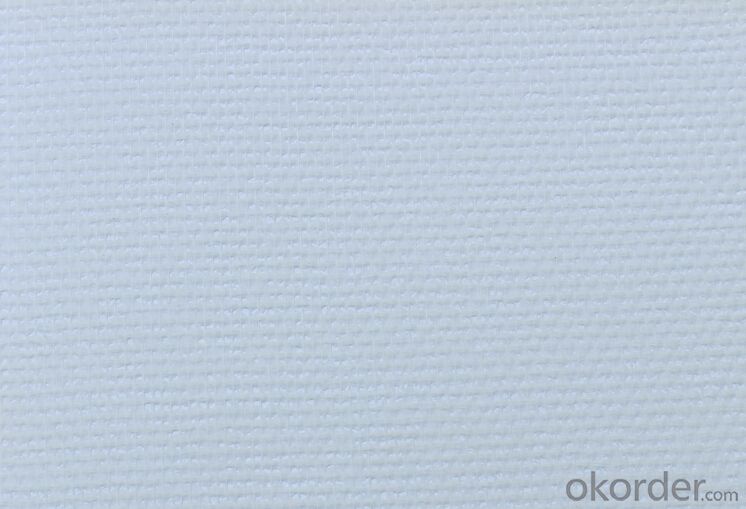
Application of Wallcovering Cloth
As a high-tech indoor decorating material,fiberglass wallcovering cloth is widely used in resident homes,
offices and shops and even cinemas,theatres,hotels and hospital faclilties,air ports,office buildings,shopping centers and schools.
Test Report
Our product has passed test by SGS as follows:
EN 12956:for determination of dimensions,straightness,spongeability and washability.
EN 12149:for determination of magration of heavy metals and certain other elements,of
vinyl monomer and of formaldehyde release.
EN 20105-B02:light solidity.
Our products had passed test of Fire Retardancy M1 Class by LINE.
- Q:Does fiberglass wallcovering cloth have any specific installation requirements for electrical wiring or outlets?
- Specific installation requirements exist for electrical wiring and outlets when using fiberglass wallcovering cloth. It is crucial to avoid covering or obstructing any electrical components to prevent fire hazards, electrical malfunctions, or code violations. To meet these requirements, seeking the guidance of a professional electrician or contractor is recommended. They will evaluate the installation area and provide instructions on the proper application of the fiberglass wallcovering cloth. This will ensure that the cloth does not interfere with the electrical components, allowing easy access for maintenance or repairs. Furthermore, it is essential to adhere to local building codes and regulations that may specify additional requirements for the installation of fiberglass wallcovering cloth near electrical wiring or outlets. These regulations are put in place to protect occupants and prevent potential hazards. In conclusion, fiberglass wallcovering cloth should be installed in a manner that does not obstruct or cover electrical wiring or outlets. Consulting a professional and following local building codes will guarantee a safe and compliant installation.
- Q:What are the installation requirements for fiberglass wallcovering cloth?
- The installation requirements for fiberglass wallcovering cloth typically involve a few key steps. First, the surface where the cloth will be applied should be clean, smooth, and free of any loose debris or contaminants. This may involve removing any old wallpaper, patching any cracks or holes, and sanding down any rough spots. Next, it is important to properly measure and cut the fiberglass cloth to fit the desired area. It is recommended to leave a small overlap at the edges to ensure a seamless finish. The cloth can be cut using a sharp utility knife or scissors. Once the cloth is cut, it should be soaked in warm water for a few minutes to activate the adhesive backing. The cloth should then be applied to the wall, starting from the top and working downwards. It is important to smooth out any air bubbles or wrinkles as you go, using a smoothing tool or a clean, damp cloth. It is also important to ensure that the cloth is properly aligned and straight, especially if using multiple pieces. Any excess cloth at the edges can be trimmed off once the installation is complete. After the cloth is applied, it is recommended to let it dry completely before applying any paint or other finishes. This typically takes around 24 hours, but can vary depending on factors such as temperature and humidity. Overall, the installation of fiberglass wallcovering cloth requires careful preparation of the surface, precise cutting and application of the cloth, and proper drying time. Following these installation requirements will help ensure a successful and durable finish.
- Q:Can fiberglass wallcovering cloth be used in residential settings?
- Yes, fiberglass wallcovering cloth can be used in residential settings. Fiberglass wallcovering cloth is a versatile and durable material that offers numerous benefits for residential applications. It is commonly used to reinforce walls, provide insulation, and improve the overall aesthetics of a room. One of the main advantages of using fiberglass wallcovering cloth in residential settings is its durability. It is resistant to wear and tear, making it ideal for high-traffic areas such as hallways, living rooms, and children's rooms. It can withstand frequent cleaning and is less likely to get damaged compared to other wallcovering materials. Additionally, fiberglass wallcovering cloth is also fire-resistant, which is an important consideration for residential safety. It can help to slow down the spread of fire in case of an emergency, providing added protection to homeowners. Another benefit of using fiberglass wallcovering cloth is its ability to provide insulation. It can help to regulate the temperature in a room by preventing heat loss or gain, resulting in improved energy efficiency. This can lead to cost savings on heating and cooling bills. Furthermore, fiberglass wallcovering cloth is available in a wide range of designs, textures, and patterns, allowing homeowners to choose a style that suits their preferences and complements their existing decor. It can add a touch of elegance and sophistication to any residential space. However, it is important to note that fiberglass wallcovering cloth should be installed correctly to ensure optimal performance. It is recommended to hire a professional installer who has experience working with this material to ensure a proper and seamless installation. In conclusion, fiberglass wallcovering cloth can be a great choice for residential settings. Its durability, fire-resistant properties, insulation capabilities, and aesthetic options make it an excellent choice for homeowners looking to enhance the look and functionality of their living spaces.
- Q:Can fiberglass wallcovering cloth be used in schools and educational facilities?
- Yes, fiberglass wallcovering cloth can be used in schools and educational facilities. It is a durable and fire-resistant material that can withstand heavy use and is easy to clean, making it suitable for high-traffic areas like schools. Additionally, fiberglass wallcovering cloth is available in various designs and patterns, providing a visually appealing and customizable option for educational spaces.
- Q:Can fiberglass wallcovering cloth be used to cover existing wall damage?
- Yes, fiberglass wallcovering cloth can be used to cover existing wall damage. It is a durable material that can help reinforce and cover up imperfections on walls, providing a smooth and even surface for painting or further wall treatments.
- Q:Can fiberglass wallcovering cloth be used on uneven surfaces?
- Yes, fiberglass wallcovering cloth can be used on uneven surfaces. Its flexibility and ability to conform to different shapes makes it suitable for application on uneven or textured walls.
- Q:Is fiberglass wallcovering cloth waterproof?
- No, fiberglass wallcovering cloth is not inherently waterproof. While it is durable and resistant to moisture, it is not designed to be completely waterproof. However, fiberglass wallcovering cloth can provide some level of water resistance and can withstand occasional splashes or humidity. It is important to note that the water resistance of fiberglass wallcovering cloth may vary depending on the specific product and its installation method. If complete waterproofing is necessary, additional measures such as using a waterproof primer or sealant may be required.
- Q:Can fiberglass wallcovering cloth be used in exterior insulation systems?
- Yes, fiberglass wallcovering cloth can be used in exterior insulation systems. It provides excellent durability, insulation, and protection against moisture, making it suitable for outdoor applications.
- Q:Can fiberglass wallcovering cloth be used in exterior window surrounds or trim?
- When it comes to exterior window surrounds or trim, it is generally not recommended to use fiberglass wallcovering cloth. Although fiberglass is a durable and versatile material, its primary purpose is for interior applications like walls and ceilings. Exterior window surrounds and trim are constantly exposed to different weather conditions, including rain, sunlight, and temperature changes. These elements can gradually deteriorate the fiberglass cloth and compromise its effectiveness. Instead, it is advisable to opt for materials specifically designed for exterior use, such as PVC or vinyl trim, aluminum, or wood. These materials are better equipped to withstand the elements and offer long-lasting protection for your windows and exterior surfaces.
- Q:Can fiberglass wallcovering cloth be used in historical restoration projects?
- Historical restoration projects can incorporate fiberglass wallcovering cloth, despite it not being the most conventional choice. The material's durability and strength make it a practical option for maintaining the building's structural integrity. Strengthening weakened or damaged walls is made possible through the use of this cloth, providing additional support and stability. Moreover, fiberglass wallcovering cloth's resistance to moisture, mold, and mildew makes it well-suited for historical buildings that are susceptible to these issues. By preventing water damage and the growth of harmful substances, the cloth ensures the long-lasting nature of the restoration project. Furthermore, the installation process is simplified due to the ease with which fiberglass wallcovering cloth can be applied to existing surfaces. This feature expedites the restoration process, while simultaneously concealing any imperfections and delivering a smooth, flawless finish that enhances the overall appearance of the renovated structure. Nevertheless, it is crucial to approach the use of fiberglass wallcovering cloth in historical restoration projects with caution. Consulting experts in historical preservation is essential to guarantee that the material aligns with the building's historical accuracy and integrity.
1. Manufacturer Overview |
|
|---|---|
| Location | |
| Year Established | |
| Annual Output Value | |
| Main Markets | |
| Company Certifications | |
2. Manufacturer Certificates |
|
|---|---|
| a) Certification Name | |
| Range | |
| Reference | |
| Validity Period | |
3. Manufacturer Capability |
|
|---|---|
| a)Trade Capacity | |
| Nearest Port | |
| Export Percentage | |
| No.of Employees in Trade Department | |
| Language Spoken: | |
| b)Factory Information | |
| Factory Size: | |
| No. of Production Lines | |
| Contract Manufacturing | |
| Product Price Range | |
Send your message to us
Fiberglass Wallcovering Cloth for Home Decoration
- Loading Port:
- Shanghai
- Payment Terms:
- TT OR LC
- Min Order Qty:
- 100 m²
- Supply Capability:
- 100000 m²/month
OKorder Service Pledge
OKorder Financial Service
Similar products
New products
Hot products
Hot Searches
